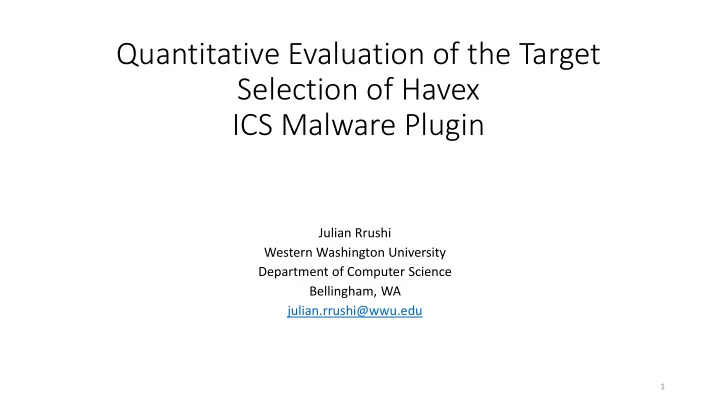

Quantitative Evaluation of the Target Selection of Havex ICS Malware Plugin Julian Rrushi Western Washington University Department of Computer Science Bellingham, WA julian.rrushi@wwu.edu 1
Outline • Research problem investigated • Target selection features measured • Decoy OPC tag deployment • Trials • Target selection measures • Quantitative analysis • Conclusions • Questions 2
Target Selection Features Measured • Ability to discover true servers over the network from the compromised machine • Ability to ignore or discard nonexistent or absent servers on the network • Ability to determine whether or not a network server hosts COM objects and interfaces • Ability to find true OPC server • …and dismiss COM objects that are not OPC 3
Other Important Feature • Ability to differentiate between valid and invalid OPC tags • Honeytoken OPC tags • OPC tags that are no longer mapped to a location in the memory of a controller • Not implemented due to safety reasons • Requires an IED configured to monitor and control the passage of electrical power from one circuit to another • OPC tags updated based on the IED scans • Those would be the target tags 4
Decoy OPC Tag Display 5
Deceptive Emulation 6
Trials • Signal trials • Consist of true targets, i.e., server machines, COM objects, OPC server objects • Targets exposed to Havex • Empirically observed whether Havex recognizes those targets as valid • Noise trials • Consist of fake or nonexistent targets • Fake targets exposed to Havex as well • Empirically observed whether Havex pursues those targets 7
Factors of Interest • Response bias • A general tendency to deem a target to be valid or invalid, i.e., signal or noise, respectively • Sensitivity • The degree of overlap between the valid-target and invalid-target probability distributions • Involves the internal reasons that cause Havex to pursue a target • Both factors are affected by the hit rate and the false-alarm rate 8
Measures of Sensitivity (I) • d ’ measures the distance between the mean values of those probability distributions in standard deviation units • d ’ close to 0 indicates inability to distinguish between valid and invalid targets 9
Measures of Sensitivity (II) • A’ is a measure that ranges between 0.5 and 1.0 • 0.5 indicates inability to distinguish between valid and invalid targets • 1.0 indicates full ability to distinguish valid targets from invalid targets 10
Measures of Response Bias • β measure • When β<1, there is bias towards accepting a target as being valid • When β>1, there is bias towards discarding a target as invalid 11
Server Trials • Windows machine infected by Havex • Signal trials • The machine had access to real servers over the network • Havex recognized most existing servers as valid targets • Noise trials • No real servers, only server displays • Havex pursued most of the phantom servers as valid targets 12
Measurements • d ’=0.179, and thus close to 0 • A’=0.576, and thus close to 0.5 • β=0.791 and thus <1 • Havex has the tendency to recognize as a valid server any software component that can respond to network queries 13
Probability Distributions 14
COM Object Trials • A real server was reachable by Havex over the network • Signal trials • The server hosted true COM objects and interfaces • Havex recognized most of the existing COM objects as valid targets • Noise trials • The server generated a fake response when queried for COM objects and interfaces • No true COM objects and interfaces • Havex accepted most of those nonexistent objects as valid targets 15
Measurements • d’= 0.196, and thus relatively close to 0 • A’= 0.589, and thus close to 0.5 • β= 0.723 and thus <1 • Havex is biased towards accepting as a valid target any server that claims to host COM objects and interfaces 16
Probability Distributions 17
OPC Server Object Trials • A real server with support for COM was reachable by Havex over the network • Signal trials • The server hosted true OPC server objects • Havex recognized most of the existing OPC server objects as valid targets • Noise trials • The server returned lists of OPC server objects that did not exist • No true OPC server objects were involved • Havex accepted most of those nonexistent OPC server objects as valid targets 18
Measurements • d’= 0.1864, and thus relatively close to 0 • A’= 0.775, and thus still relatively close to 0.5 • β= 0.018 and thus <1 • Havex is biased towards accepting any claim of OPC server object as valid 19
Probability Distributions 20
All questions and feedback are welcome! 21
Recommend
More recommend